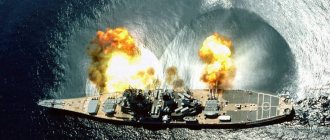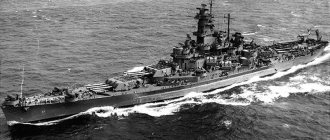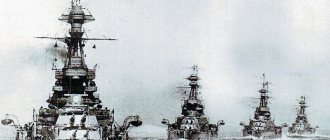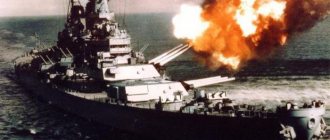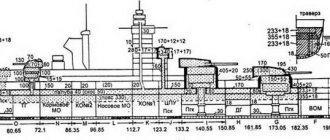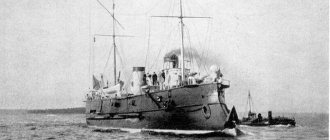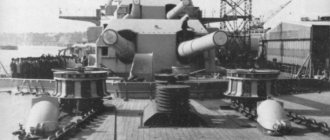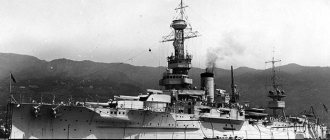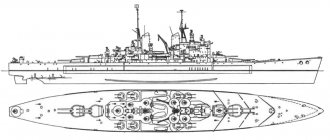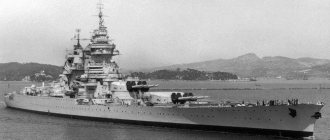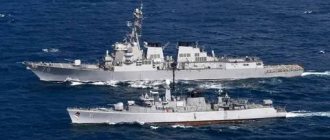Sea cruises are very popular among tourists all over the world, as they provide a unique opportunity, during one trip on a 5* floating hotel with an All Inclusive or Ultra All Inclusive meal plan, to enjoy the beauty, history and ancient architecture of numerous port cities and relax on superb beaches
Weighing over 58,000 tons and measuring just under 274 meters from stem to stern, the USS Battleship Missouri is an enormous, awe-inspiring behemoth. A true force to be reckoned with in its prime, today the peaceful giant silently stands guard over Pearl Harbor, impressing tourists all over the world with its characteristics. At the end of the article you will find an interesting video about the characteristics of the battleship Missouri.
Battleship concept
The battleship was originally conceived as the main ship for naval service and combat operations. These were large ships, equipped with the largest caliber at that time, had high combat characteristics, reinforced armor and powerful engines. The American battleships of the Iowa family are considered the most advanced type of ships of this class.
It was these ships that managed to achieve maximum harmony between such indicators as speed, armor and weapons. They were a point in the development of the class and were its last representatives. 6 ships were planned, but only 4 were built - Missouri, New Jersey, Wisconsin, Iowa. 2 more ships - "Illinois" and "Kentucky" - were never completed. This initiative by the leadership of the US Navy is explained by the fact that Japan has launched the Yamato family of heavy battleships. The Iowa class ships were supposed to resist them.
US Navy warship Missouri (BB 63) - difficult path, history, fate
When thinking about the class of battleships, several ships of this class come to mind that were of historical significance. Among them will definitely be the American battleship Missouri. The ship's drawings make it possible to see that it was a smooth-deck battleship with three gun turrets and a highly developed central superstructure. But it is not only military exploits that make this ship so important, because it influenced not only the course of world history, but also the development of shipbuilding. The famous ship took 4 years to build, from 1940 to 1944. Approximately 10,000 people worked on its construction. When launched, the ship was given the name "Missouri" and the number BB 63. The crew itself subsequently gave it the nickname "Big Mo". At that time, it was the largest ship in service with the US Navy. In addition, she is the largest warship in the US Navy to this day, her record has never been broken.
Projectiles used
For shooting, monstrous shots were used, the powder charge of which alone weighed almost three centners. He could launch a projectile weighing 1225 kilograms over a distance of almost forty kilometers. The range of ammunition included both armor-piercing and high-explosive fragmentation varieties. But not only these shells were in the arsenal of the Iowa ship. The battleship was armed with Mk-5 rounds, the weight of which was 1116 kilograms. Closer to 1940, the US Navy also received the MK-8 shell, which (like older varieties) also weighed 1225 kilograms.
In general, shots of this weight and caliber became the basis of the firepower of American ships, starting with the North Carolina. It may seem incredible, but only 1.5% of the weight was the actual explosive charge. However, this was still enough to penetrate the armor of enemy ships. Thus, in the events in the Pacific Ocean during the war with the Japanese, it was the Iowa that distinguished itself. The battleship, a photo of which is in the article, repeatedly participated in clearing the water area of enemy ships.
Battleship "Missouri" - characteristics
- Displacement (actually the weight of the ship) is 48,300 tons.
- The length of the hull is 270.5 meters.
- Width - 33 meters.
- The draft in the water is 11 meters.
- The maximum speed of the ship is 33 knots (61 km/h).
- Power plant - T3A (4 pieces) with a capacity of 200,000 hp. With..
- Crew - 1851 sailors and officers (depending on the tasks assigned to the ship, this number could change).
Battleship armament
- 406 mm caliber guns - 9.
- 127 mm caliber guns - 18.
- Anti-aircraft guns of 20-25 mm caliber - more than 100.
- Anti-ship complexes of the "Harpoon" type - 16.
- Tomahawk class missiles - 32.
- Anti-aircraft installations "Phalanx" caliber 20 mm - 4.
- Anti-aircraft missile systems "Stinger" - 5.
The ship's armament was quite consistent with such impressive dimensions: the main caliber of the battleship Missouri was powerful 406-mm cannons, of which there were three in each gun turret. There were also three such towers in total. In addition to these guns, the ship also had 127 mm cannons to maintain constant fire, there were 18 of them in total.
Another feature of the Missouri design is almost absolute protection from all kinds of air raids. More than a hundred 20 and 25 mm automatic anti-aircraft guns excellently repelled the attacks of Japanese kamikazes. And all vital compartments - gun magazines, engine room, sides - were reliably protected by armor, the maximum thickness of which was 15 cm. For example, during the battles for the island of Iwo Jima, suicide bombers attacked the ship several times. The battleship Missouri did not receive any serious damage as a result of these attacks.
Ammunition storage
Ammunition was stored on two tiers in the lower compartments. The supply to the towers was also carried out by an electric motor, but in this case its power was 100 hp. As in the case of the Dakotas, the ship’s design did not contain reloading compartments that could save the crew if the ammunition exploded.
To solve this problem, the Americans have provided a rather complex system of hermetic doors. Experts often note that such a decision sharply increased the risk of death for the ship’s crew, but in practice the reliability of the battleship was confirmed. What disaster did the battleship Iowa survive? Explosion. This happened in 1989. Then the second gun turret of a 406-mm gun exploded, killing 47 people and causing the installation to catch fire. Until now, the reasons for what happened have not been precisely established.
Participation in World War II
The ship managed to take part in the final stage of World War II. With his support, many landing operations or battles were carried out - Ulithi Strait, Okinawa, Iwo Jima. Its powerful guns effectively suppressed Japanese fortified points, thereby covering the advancing infantry. When fired, the ship rocked violently, and the rockets sucked all the air out of the gun turrets when fired. The sounds of the shot were such that many sailors (despite the fact that they had undergone special training) had to be hospitalized, as they were very ill.
The ship also went down in history due to the fact that the unconditional surrender of Japan was signed on board, and thus ended the Second World War. This happened on September 2, 1945.
Post-war life of the battleship
After the end of the fighting with Japan, the Missouri remained in service for some time. So, in 1947, President Truman made a diplomatic voyage on it, during which the battleship crossed the equator and eventually landed on the shores of the United States. Subsequently, the president spoke very warmly about his time spent with the team. It should also be emphasized that the sailors who served on the Iowa class ships were always treated with great respect. Perhaps the reason is that hard work in tropical heat required maximum effort from everyone.
After this, the glorious ship was transferred to reserve. Here he suffered his first failure - in January 1950, exercises were conducted in the Chesapeake Bay. Here the Missouri, while performing maneuvers, ran aground. The damage was serious - three fuel tanks were pierced by stones. Since the ship was filled with all kinds of ammunition and other cargo (approximately 11.7 thousand tons), urgent work was carried out to unload it. The first attempts to refloat were unsuccessful, but already in February the ship moored at a Norfolk dock, where it was repaired for 5 whole days.
Start of development
The start of work on the ships dates back to 1938.
The creators were immediately given the task of creating a fast and well-armed battleship that could follow aircraft carriers and repel attacks directed at them. The main problem was achieving a speed of 30 knots. At the same time, the first problems with Japan began, so it was necessary to hurry: many understood that the descendants of the samurai would not miss the opportunity to attack the US fleet. Without further ado, we decided to use ships of the South Dakota type as a basis. As a result, the battleship Iowa received a displacement of 45 thousand tons, and 406 mm guns became the main artillery caliber. It must be said that almost 70 meters were added to the length of the hull, but the width of the hull had to be left almost unchanged, since the Panama Canal dictated its own standards.
Participation in armed conflicts of the late 20th century
At the outbreak of the Korean War, the Missouri went on combat patrols to South Korean waters. This is the only ship that went through all three years of hostilities (1950 - 1953) without leaving the post. For this he was noted by the Korean President. In 1955, the ship was put into reserve again.
After this, the battleship, according to the program of the Ministry of Defense, was mothballed and stood in the docks for about 40 years. However, by 1980, the government had a need for powerful and fast ships (then the Cold War reached its climax). In this regard, the Iowa-class battleships, including the Missouri, were reactivated and thoroughly re-equipped and modernized. The main caliber, of course, was not touched, but only current strategic weapons were added - Tomahawk cruise missiles, special anti-ship missiles, automated anti-aircraft guns. It is worth noting that all the battleships are perfectly preserved, despite 40 years of inactivity. Subsequently, the battle group, and the battleship Missouri in particular, served in many conflicts - supporting infantry and striking Viet Cong troops during the Vietnam War, localizing hostilities during the Falklands conflict.
Nuclear Age
In the early 50s, the Mk-23 projectile came into service, which was equipped with a nuclear charge with a power of 1 kt.
It weighed “only” 862 kilograms, had a length of just over one and a half meters, and in appearance was practically indistinguishable from the Mk-13. According to the official version, special shells were in service with the US Navy from 1956 to 1961, but in reality they were always stored in coastal arsenals. In the early 1980s, it turned out that Iowa-class battleships had rather mediocre firing range results and that these characteristics could use serious improvement. To cope with this task, American engineers began developing a special sub-caliber projectile for 406-mm guns. Weighing only 654 kilograms, it had to fly at least 66 kilometers. But this development never left the testing stage.
The rate of fire of the guns was two rounds per minute, and each barrel could fire independently. One turret with 406 mm guns weighed approximately three thousand tons. A crew of 94 people (for each gun) was responsible for the shooting. By the way, how many people were on board the Iowa? The battleship, whose photo appears repeatedly in the article, required 2,800 sailors to fill all vacancies.
The end of combat service - the last operation
It is with the Missouri that the battleship's last combat exit to sea is associated. This happened in 1991 during the fighting in the Persian Gulf region. The last time his guns started talking was when he was assisting coalition forces in Operation Desert Storm.
So, January 17, 1991. At 1:40, two Tomahawk missiles are launched from the Missouri. What is noteworthy is that this is the first experience of firing missiles from a ship of this size, and at a long range - the targets were located in Iraq and Kuwait at a distance of approximately 1,400 km. At the same time, the old but still effective main guns opened fire on the port of Hanji in Saudi Arabia. Volleys were fired every 15 seconds. Since all the actions of the battleship—moving and shooting—were coordinated by UAVs from the air, the Missouri did not receive a single damage. Enemy positions were covered by a sea of fire, because the power of 406 mm guns, combined with modern guidance systems, was truly destructive. These salvoes became a farewell salute and the end of the century of battleships, which bore the brunt of many battles and combat duties, proving that the battleship is an effective and formidable weapon.
But the age of aircraft carriers was approaching, so the battleship Missouri was ending her service. In 1992, it was removed from the active fleet. Before her “retirement,” the battleship made a memorable journey to the shores of Japan, to the place where World War II ended. After that, he headed to his native shores. At the port of Long Beach, all weapons and important equipment were removed from him. Now it is permanently moored in the port of Pearl Harbor in the Hawaiian Islands and is a museum ship. She is interesting not only because of her fame, but also because she is the only ship of the battleship class remaining in working condition. It is also of interest to modelers who, thanks to modern technology, can assemble a model of the battleship Missouri at home and add it to their collection of warships.
